SCOTTISH HIGHLANDER
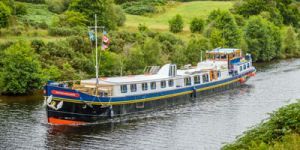
Caledonian Canal (includes Loch Ness)
Up to 8 guests
Charters and Cabin cruises
Themed Cruises:
Family, Fishing, Golf, Whisky

The Caledonian Canal bisects the Scottish Highlands from Fort William in the south west to Inverness in the north east, passes brooding castles and connects dramatic, deep-water lochs.
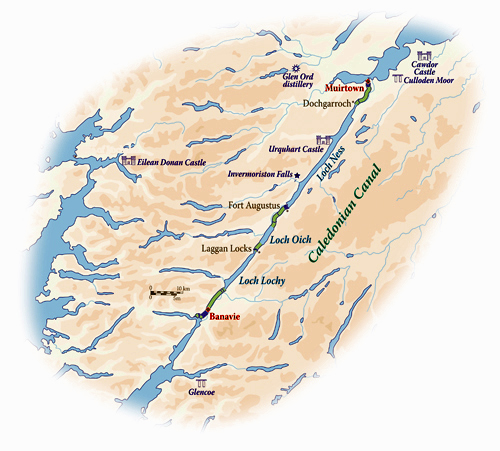
Cruise the Caledonian Canal between Banavie and Muirtown
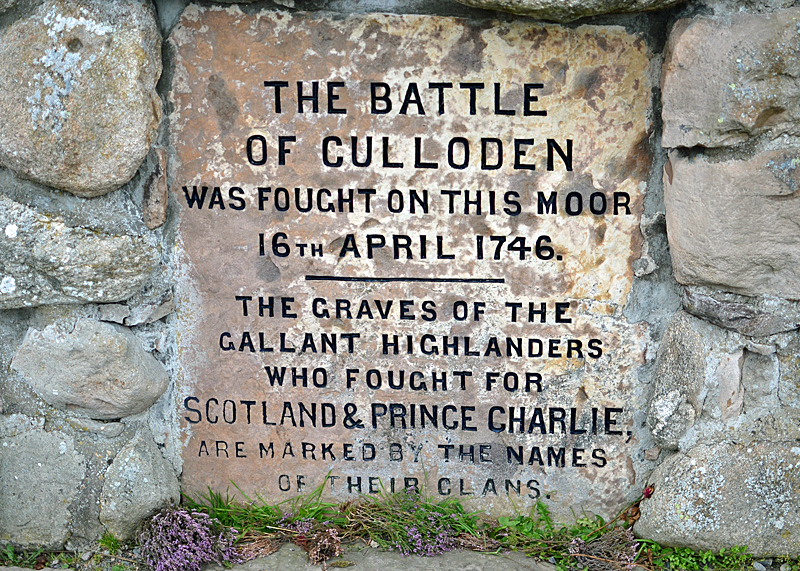
On 16 April 1746, the Battle of Culloden Moor was the last pitched battle ever to be fought on British soil. It marked the end of the Jacobite struggle for the British throne that had started in 1688. Determined to reclaim the throne for his father, Bonnie Prince Charlie, son of James VIII, marched as far south as Derby before realizing that his cause was hopeless and turned home to ultimate defeat at Culloden.
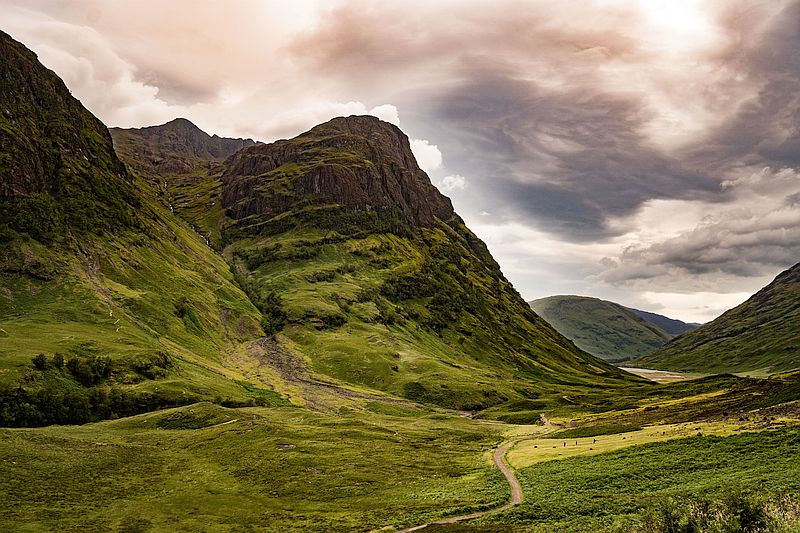
Glencoe is one of the most infamous places in Scotland
Perhaps the most infamous and melancholic place in the Scottish Highlands is Glencoe. On the morning of 13 February 1692, a regiment of Campbells, under orders from the Secretary of State for Scotland, the 1st Earl of Stair, fell upon their hosts the MacDonalds and “put all to the sword under seventy”. About 30 members and associates of the MacDonald clan were killed by the government forces billeted with them. They left countless others to die of exposure in the winter snows because they had not been prompt in pledging allegiance to the new monarchs, William III of England (II of Scotland) and Mary II.
Although in terms of numbers, this was by no means the worst of the massacres that marked the Highland feuds. The Glencoe Massacre takes on a peculiar notoriety because of the collusion of the Crown and the cold-blooded way the honored guests committed such heinous “murder under trust”. Glencoe was the perfect setting for a dark and treacherous deed. Even on summer days, it is a grim, forbidding place; a great cleft driven through the black, sullen mountains bereft of warmth or sunlight.
Old Inverlochy Castle is a ruined, 13th-century castle near Inverlochy and Fort William. The castle, the site of two major battles, is unusual as it remains largely unchanged since its construction during the reign of King Alexander III. Built on the site of an earlier Pictish fortification, Viking forces destroyed the castle. Its simple layout comprises a quadrangular courtyard surrounded by a wall up to 2.7m thick and up to 7.6m high, with round towers at each corner. The main entrance was to the south, with a “water gate” facing the river to the north and defended by a portcullis and an interior gatehouse.
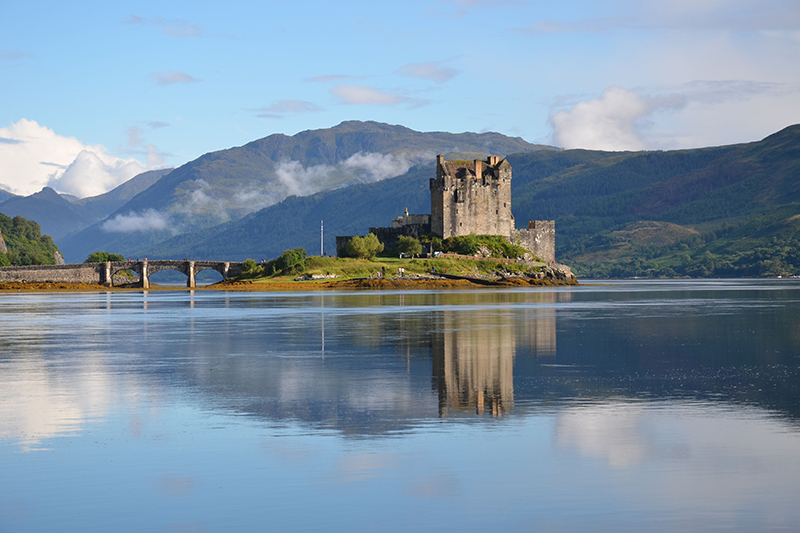
Eilean Donan is one of Scotland’s most photographed castles
Possibly the most photographed monument in Scotland, Eilean Donan is everything an ancient Highland fortress should be. Less than 100 years ago, it was nothing more than a pile of stones, having been blown to pieces by Royal Navy warships during the Jacobite uprising of 1719. At that time, it housed a Spanish garrison supporting the Old Pretender. Home of the MacRaes, Lieutenant-Colonel John MacRae Gilstrap restored Eilean Donan at great expense between 1920 and 1932. It has since appeared in many films, most notably the 1986 film Highlander, as well as the MI6 Headquarters in the 1999 James Bond film, The World is Not Enough. Eilean Donan is one of the best visits along the Caledonian Canal.
Loch Ness fills the northern half of the Great Glen that divides Scotland. It is 22.6 miles long and has an average depth of 427 feet, making it not only the longest lake in Britain but having the greatest volume of water of any lake in Britain. Loch Ness has more water than all the lakes and reservoirs in England put together. In fair weather, the unrivaled beauty of Loch Ness and its setting sometimes disappoints visitors to the Caledonian Canal who are expecting black, icy waters, lowering mists and monsters. In 595, St Columba was the first person to sight the infamous Loch Ness Monster, now affectionately known as Nessie, while he was traveling north to convert the Pictish King Brude at Craig Phadrig. The modern legend began in 1933, when the Loch became more accessible thanks to roads constructed along the northern bank. A local couple were driving home along the new road, when they were alarmed to see “an enormous animal rolling and plunging on the surface”. The editor of the Inverness Courier headlined the story with “monster” and since then, despite hundreds of sightings and photographs, theories and scientific expeditions, no one has proved the monster’s existence.
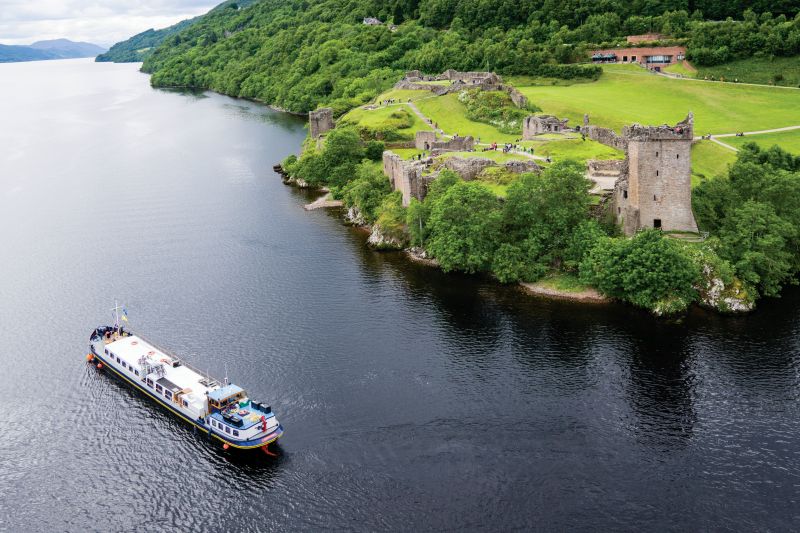
Hotel Barge Scottish Highlander cruises past Urquhart Castle
The romantic ruins of Urquhart Castle sit on the shores of Loch Ness on the site of a much earlier medieval fortification. Founded in the 13th century, Urquhart Castle played an important role in the Wars of Scottish Independence of the 14th century and was subsequently held as a royal castle. Granted to the Grant Clan in 1509, the MacDonalds raided it on several occasions. Despite being strengthened to defend against raids, they largely abandoned the castle in the mid-17th century. In 1692, Urquhart was partially destroyed to prevent its use by Jacobite forces and subsequently decayed. By the 1770s, the castle was roofless and regarded as a romantic ruin by 19th-century painters and visitors to the Highlands. In 1913, the castle was placed in care as a scheduled monument and is today open to the public, being one of the most visited castles in Scotland.
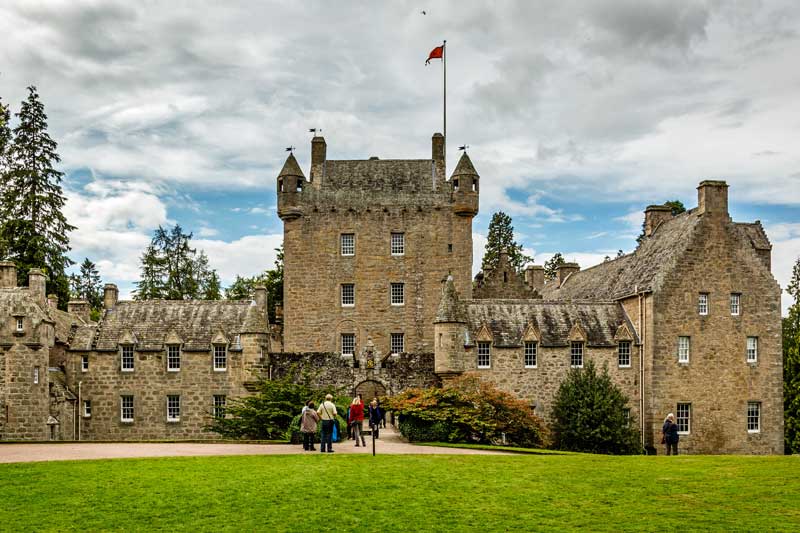
Cawdor Castle is magnificent and moody with its deep dry moat, brooding square tower, portcullis and the only surviving drawbridge at a private castle in Scotland. Though Macbeth may not have actually killed Duncan here, it feels like the sort of place where he might have done, and certainly in a much earlier building. The Keep, the oldest part of what remains today, only dates from the 15th century. The original name of the land and the castle was Calder, and the family was the Calders of Ilk. Pronounced Cawdor by the locals, it was by this name that Shakespeare would have heard the castle called when he visited Scotland to research his new play.
Legend has it that, in the 14th century, a local Thane (an Anglo Saxon nobleman) treated himself to a fortress. A dream guided him to load a donkey with a chest of gold, let it go free, and build his castle where the donkey lay down to rest. If he did this, he was told, his family would prosper. The beast wandered for a while before finally resting under a holly tree, and the obedient Thane erected the Keep around the tree. The ancient holly tree, now dead though still standing, can be seen growing out of the floor of the dungeon and up through a hole in the ceiling. Modern science has proven the tree to date from 1372. This visit is a must when cruising on the Caledonian Canal.
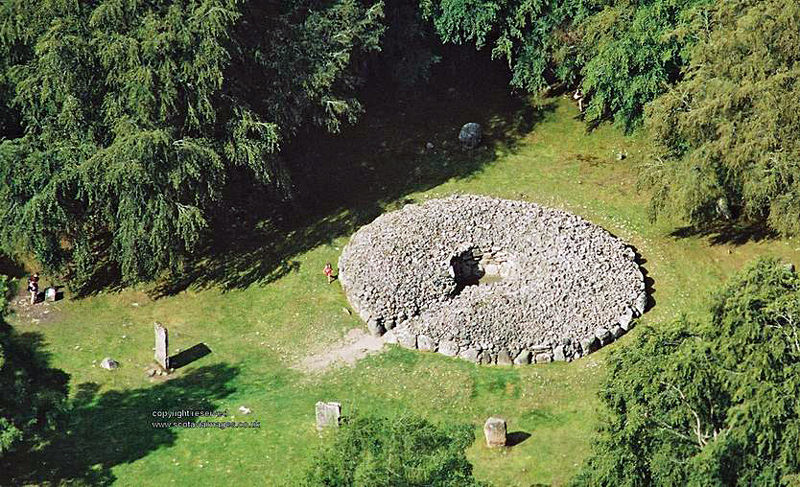
Balnuaran of Clava is one of the best preserved Bronze Age burial sites in Scotland. The site primarily comprises what appear to be three circular piles of rocks approximately 50 feet in diameter, encircled by standing stones. Approximately fifty Bronze Age circular tomb chambers have been discovered around the area of Inverness. Scientific research has unearthed little about the origin of the structures, leaving them as monuments to the mysterious life of Scotland’s early inhabitants.
Fort George is a large, 18th-century fortress near Ardersier, based on a star design and built to control the Scottish Highlands in the aftermath of the Jacobite Rising of 1745. The current fortress has never been attacked and has remained in continuous use as a garrison. Work on the fortresses started in 1748 and by 1757, the primary defenses were in place before being finished in 1769. Though the barracks are still in use as a military establishment, the site is open to the public with various exhibits and reproductions showing the fort’s use at different periods.
On the afternoon of Monday, 19 August 1745, Bonnie Prince Charlie stepped out of a small rowing boat at Glenfinnan, at the head of Loch Shiel. A troop of 50 MacDonalds awaited him. While the Prince took shelter in a barn, more MacDonalds, Camerons and MacDonnells arrived, swelling his ranks to some 1,300 men. Charles climbed today to the top of one of the smaller hills, raised his father’s standard, gave a small speech, and distributed brandy all round. The Glenfinnan Monument, commemorating the event, was erected in 1815 and is now in the care of the National Trust for Scotland. The statue at the top of the monument is not of Bonnie Prince Charlie himself, but represents all the Highland clansmen who gathered there to fight.
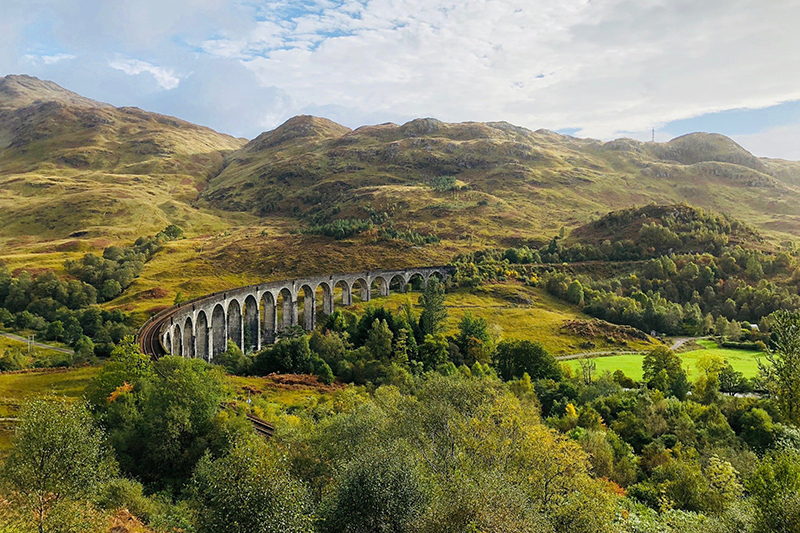
The Glenfinnan Viaduct was featured in Harry Potter films
Overlooking the shores of Loch Shiel and the Glenfinnan Monument is the Glenfinnan Viaduct which carries the West Highland Line between Fort William and Mallaig. Built in 1897, the railway viaduct comprises 21 arches over the River Finnan and has featured in several films, most notably Harry Potter. This is a popular visit for families when cruising the Caledonian Canal.
Inveraray Castle was the first major neo-gothic castle to be built in Britain. Home to the chief of one of Scotland’s most powerful clans, the Campbells, Dukes of Argyll. The second Duke was one of the British Army’s first two field marshals. It is said the fifth Duke married one of the Gunnings sisters, considered to be the most beautiful women in Europe. The castle’s State Dining Room, completed in 1784, is considered the finest painted room in Britain, as well as the only surviving work anywhere of the French painters Girard and Guinard.
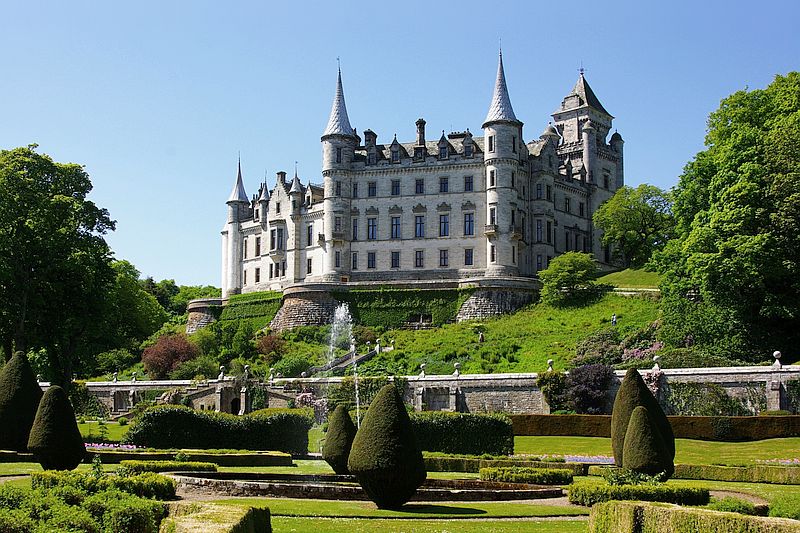
Dunrobin Castle resembles a Bavarian castle
Dunrobin Castle is one of the most extraordinary sights in Scotland; a vast, flamboyant fairy castle of pinnacles and turrets set high on a cliff overlooking the North Sea. Hidden within all this extravagance is the ancient 13th-century family seat and one of the oldest continuously inhabited houses in Britain. The Earldom of Sutherland dates back to 1235, when the Scottish Kings took these northern lands back from the Norse and scattered titles and territories to their friends and supporters.
The original keep was built in 1275 and was added to over the centuries, mainly during the reign of Charles II in the 18th century. The architect Sir Charles Barry of Houses of Parliament fame designed the ocean-facing façade that greets the world today. Barry also laid out the formal gardens, which were inspired by those at Versailles and remain virtually unchanged since their creation.
The castle has 189 rooms and is the most northerly of Scotland’s great houses and is the largest residence in the northern highlands. The upper floors are rumored to be haunted by the daughter of the 14th Earl who fell to her death, climbing from an attic window while attempting to elope.
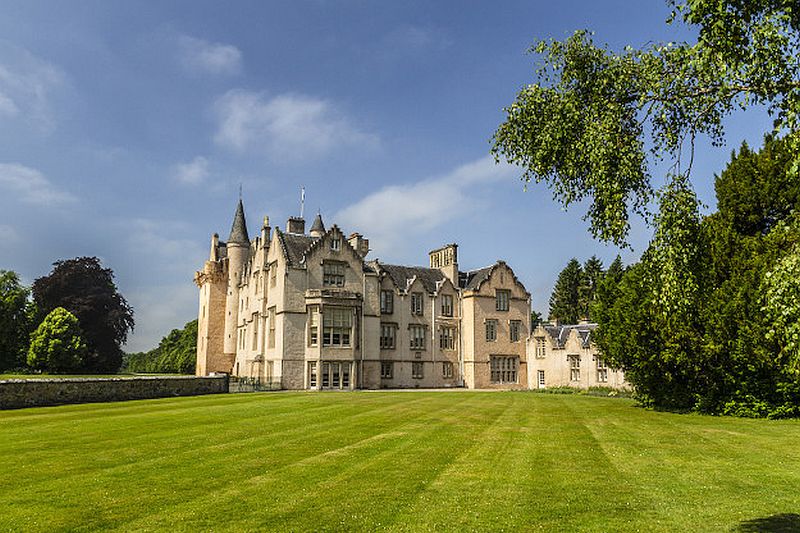
Brodie Castle was home to the Brodie family for more than 800 years
The Brodie Castle, originally built in a Z-plan in 1567 by the Brodie clan, was destroyed by fire in 1645 by the Gordon clan. In 1824, the architect William Burn was commissioned to convert the ruins into a large mansion house in the Scots Baronial style. They did not complete these additions. James Wilson later remodeled the castle in circa 1845. The Brodie family called the castle home until the early 21st century. The Brodies have been associated with the area since the 12th century, when the land was given to them by King Malcolm IV. Since 2017, the castle and its surrounding gardens have been owned by the National Trust for Scotland. Its well-preserved interiors contain fine antique furniture, oriental artefacts, and painted ceilings dating from the 17th-19th centuries.
The land around Beauly is very fertile. Historically, corn was extensively grown in the area, though today fruit is successfully farmed. The town is the site of the Priory Church of the Blessed Virgin and John the Baptist, also known as Beauly Priory, which was founded in 1230 by John Byset of the Aird for Valliscaulian monks. Following the Reformation, the buildings, except for the church (which is now a ruin) passed into the possession of Lord Lovat.
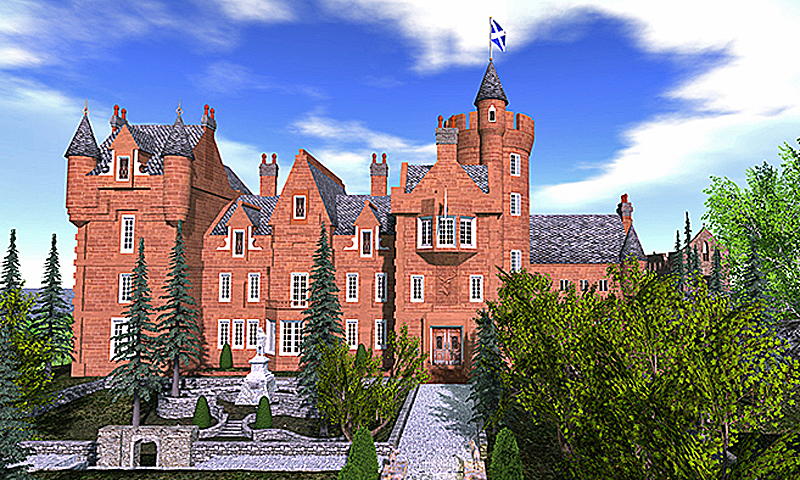
Beaufort Castle
Beaufort Castle, near Beauly, is a Baronial style mansion built in 1880 incorporating older building work, on the right bank of the River Beauly. The traditional seat of the Lords Lovat, there has been a castle on the site since the 12th century. In 1815, Thomas Fraser of Steichen inherited the estate and was reinstated to the Lordship of Lovat in 1854. He commissioned William Burn to extend the house and also improve the grounds and surrounding estate. His son, Simon Fraser, the 13th Lord Lovat, built the present Beaufort Castle to designs by James Maitland Wardrop, incorporating part of the 18th-century house. In 1994, the castle was sold to Anne Gloag, director of the transport group, Stagecoach.
On a windswept plateau above Spean Bridge is the striking Commando Memorial, unveiled by the late Queen Mother in 1952. In the summer of 1940, during Britain’s darkest hour, Prime Minister Winston Churchill called for the raising of an elite force of men to take on the Axis powers in Europe and regain the initiative for Britain. Only the best fighting men earned the right to wear the Commandos’ green beret and the enemy soon learned to fear them. Their motto was “United We Conquer”. Their training ground was here in the rugged terrain of Inverness-shire.
The Highland Folk Museum is an open-air museum and visitor attraction in the Highlands. Its origins trace back to 1930, when Dr. Isabel Frances Grant organized and curated the Highland Exhibition in Inverness, in which over 2,100 artefacts were exhibited as a “national folk museum”. She founded the subsequent Highland Folk Museum five years later, using a personal legacy to acquire a disused former United Free Church on the island of Iona. Today, the museum is primarily made up of three areas that represent and interpret three separate eras of the Scottish Highlands. Each area is interpreted by a staff member dressed and performing as a Highlander. On certain days throughout the year, the museum features demonstrations of highland life activities, such as weaving or rope making.